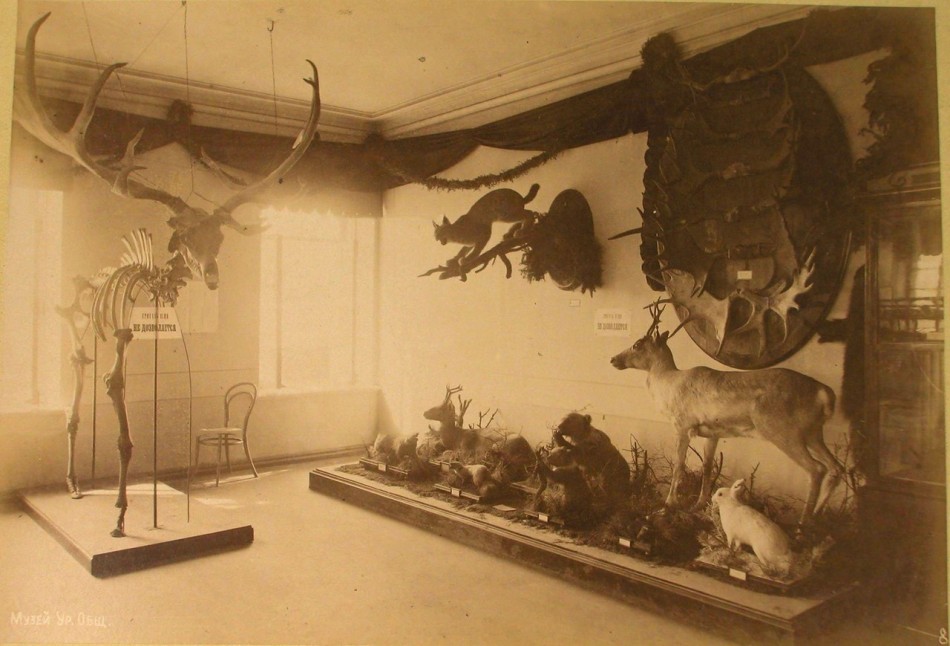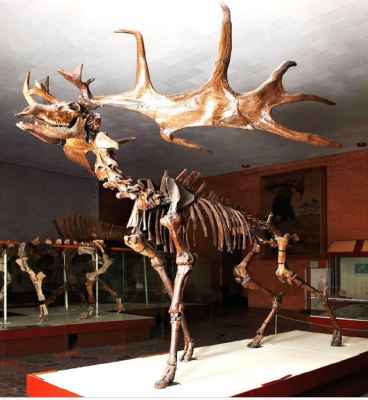the place where Paleontology and Paleoanthropology meets Philately
Russia 2020 "Paleontologic Heritage of Russia"
| Issue Date | 03.06.2020 |
| ID | Michel: Scott: UPU: Category: pR, pF |
| Designer |
stamps: Vladimir Ivanovich Beltyukov FDC: N. Karpova |
| Consultant | Staff of Paleontologic Museum in Moscow |
| Stamps in set |
40 RUB - Inostrancevia (Inostrancevia alexadri) 40 RUB - Russian pliosaurus (Pliosaurus rossicus) 40 RUB - Woolly mammoth (Mammuthus primigenius) 40 RUB - Giant Deer (Megaloceros giganteus) Total stamps in set: 4 |
| Size | stamps size: 65×32.5 mm, Mini-Sheet size: 150×157 mm |
| Layout | Mini-Sheet of 8 stamps (two sets) of type 1 (regular) Mini-Sheet of 8 stamps (two sets) of type 2 (with sand incorporated on the stamps) Type 2 stamps sold insid of Souvenir Folder only. |
| Products | FDC: 24 (4 covers with 1 stamp each x 6 different postmarks), FDC Cover without stamps: 1, Souvenir Booklet: 1 |
| Paper | Coated |
| Perforation | 11.75x11.75 |
| Print Technique | Offset + security system |
| Printed by | |
| Quantity | 30.000 Mini-Sheets of type 1, 5.500 Booklets with Mini-Sheet of type 2 |
| Issuing Authority | MARKA Publishing & Trading Centre |

On June 3rd, 2020 Post Authority of Russia issued a set of 4 stamps depicting some prehistoric animals and their fossils (skulls) - "Paleontological Heritage of Russia".
Paleontology is the scientific study of fossil remains of plants and animals. Its main task is to study and reconstruct on the basis of the found remains the habits, biological features, methods of nutrition and reproduction of extinct animals, as well as to restore the course of their biological evolution.
These stamps shows a large variety of prehistoric animals from different eras of the Earth's geological history that have been found in rocks in the territory of modern-day Russia (include occupied territories - Crimean Peninsula [PM1]).The postal stamps provide images of fossil remains and reconstructed images of Inostrancevia alexadri, Pliosaurus rossicus (Russian pliosaurus), Mammuthus primigenius (Woolly Mammoth), Megaloceros giganteus (Giant Deer). [R1]
Inostrancevia, originally spelled with "z" Inostranzevia, is an extinct genus of carnivorous therapsid from the Permian period (about 260–254.2 million years ago).
"The Permian Period derives its name from the Russian region of Perm, where rocks deposited during this time are particularly well developed." ENCYCLOPADIA BRITANNICA

Reconstruction of Inostrancevia on the stamp is horizontally flipped image from a reconstruction (image to right) by Soviet Paleontologist and Artist Alexey Petrovich Bystrov. The original, color, picture is exhibited at the Paleontological Museum of the Russian Academy of Sciences (Moscow), shows an individual of Inostrancevia preying upon a Pareiasaur. Pareiasaurs were a group of anapsids reptiles related to modern turtles. The image of the skull on the stamp is from the most complete skeleton of Inostrancevia that is on exhibit at the Paleontologic Museum in Moscow. Excavated in 1899 in North Russia, by famous Russian paleontologist Vladimir Prokhorovich Amalitskii. 
Image is from izi.travel website |
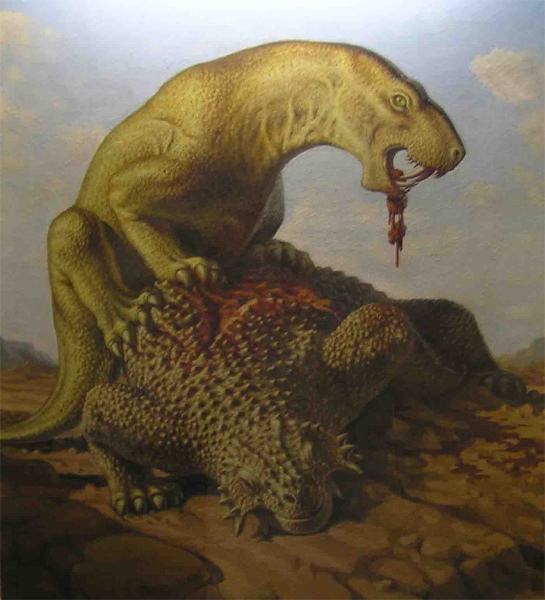 The most famous painting of Soviet Paleontologist and Artist Alexey Petrovich Bystrov (1899—1959),
"Inostrancevia devouring a Pareiasaur", shows reconstrctions of Inostrancevia alexandri and Scutosaurus karpinskyi.
This reconstruction appeared for the first time, as a black and white image, in an article of Bystrov,
" ОПЫТ РЕКОНСТРУКЦИИ НЕКОТОРЫХ ПРЕДСТАВИТЕАЕЙ СЕВЕРО-ДВИНСКОЙ ФАУНЫ"
(“The experience of reconstruction of some representatives of the North Dvina fauna”)
published in "ТРУДЫ ПААЕОЗООАОГИЧЕСКОГО ИНСТИТУТА, ТОМ IV" (TRAVAUX DE l’INSTlTUT PALÊOZOOLOGIQUE
DE l’ACADÉMIE DES SCIENCES DE l’URSS TOME ‘IV) in 1935, written on Russian and German.
The most famous painting of Soviet Paleontologist and Artist Alexey Petrovich Bystrov (1899—1959),
"Inostrancevia devouring a Pareiasaur", shows reconstrctions of Inostrancevia alexandri and Scutosaurus karpinskyi.
This reconstruction appeared for the first time, as a black and white image, in an article of Bystrov,
" ОПЫТ РЕКОНСТРУКЦИИ НЕКОТОРЫХ ПРЕДСТАВИТЕАЕЙ СЕВЕРО-ДВИНСКОЙ ФАУНЫ"
(“The experience of reconstruction of some representatives of the North Dvina fauna”)
published in "ТРУДЫ ПААЕОЗООАОГИЧЕСКОГО ИНСТИТУТА, ТОМ IV" (TRAVAUX DE l’INSTlTUT PALÊOZOOLOGIQUE
DE l’ACADÉMIE DES SCIENCES DE l’URSS TOME ‘IV) in 1935, written on Russian and German.
|
Inostrancevia is one of the largest representatives of extinct predatory therapsids (a group that includes mammals and their reptilian ancestors) from the Gorgonopsian suborder, predators characterized by long, saber-tooth-like canines. Some paleontologists suggest that the skin may have been covered with hair.
Inostrancevia had an average mass of 300 kg and was about 4 meters long. It shared its habitat with Scutosaurus and Pareiasaurus which it likely preyed upon. Its lifestyle resembled a modern crocodile.
Inostrancevia had a light and slender skeleton, which indicates the mobility and agility of the animal. It had a powerful skull: a high, laterally compressed facial part, a high lower jaw, huge dagger-like fangs hanging downwards and dagger-like incisors. The upper canines are provided with huge roots and resemble the canines of saber-toothed cats. The teeth were probably quickly replaced (the replacement fang grew out behind the main one) and easily fell out. The jaw apparatus of a Inostrancevia is peculiar.
According to paleontologist M.F. Ivachenko the jaw's construction and the location of the teeth allowed the animal only to tear off pieces of meat from its prey instead of chewing like modern mammalian carnivores. Such jaws are effective only for cutting large prey and Inostrancevia would have had to swallow the pieces of meat whole. Moreover Inostrancevia had an unusual attachment of cranial bones. During the bite, the bones slightly diverged to the sides, while the upper fangs turned slightly and stood in line with the lower. This allowed the lizard to cut large pieces of meat from the carcass.
The lower fangs of Inostrancevia were almost as large as the upper. The upper fangs had a curious feature: they sat weakly in the jaw. This adaptation protected Inostrancevia from damaging its jaws when it was killing prey. If the prey was energetically thrashing, the canines would fall out instead of breaking off. Losing the canines was not a problem though, because there were two or three interchangeable fangs in the form of embryo-crowns. As soon as the old fang flew out, the spare immediately moved into position, and a few weeks later a brand new large fang sat in the jaw. Periodic rotation of the fangs also passed. Throughout life, the fangs of Inostrancevia changed dozens of times. It is no coincidence that in mass graves canines are often found separately. [R2]
First discovered by a Russian paleontologist Vladimir Prokhorovich Amalitskii (1859-1917) in 1899 and named it after his mentor, great Russian geologist and paleontologist Alexander Alexandrowitsch Inostranzev - Inostrancevia alexandri.
Inostrancevia alexandri presented to the science community for the first time in 1901 at a Congress of Russian Naturalists and Doctors. Described by Amalitskii, but published 5 years after his death, in 1922.
 Since his days as a student time, Amalitskii collected and studied fossilized shells of freshwater
bivalves of the Permian period. The first shells he found in the Nizhny Novgorod region, later on
in the Arkhangelsk region (North of Russia). Slowly he became an expert on this topic.
He compared his shells with shells from major Paleontological Museums of Europe. In 1895 he compared his shells to
South African shells
(Karoo formation) fin the collection of the Natural History Museum in London.
He was convinced that they were not just similar, but even identical and belonged to the same species.
The results of his research were contributed to the Geological Society of London in a paper entitled
"A Comparison of the Permian Freshwater Lamellibranchiata from Russia with those from the Karoo System of South
Africa" (Quart. Journ. Geol. Soc, vol. li, pp. 337-51, pis. xii, xiii, 1895).
Since his days as a student time, Amalitskii collected and studied fossilized shells of freshwater
bivalves of the Permian period. The first shells he found in the Nizhny Novgorod region, later on
in the Arkhangelsk region (North of Russia). Slowly he became an expert on this topic.
He compared his shells with shells from major Paleontological Museums of Europe. In 1895 he compared his shells to
South African shells
(Karoo formation) fin the collection of the Natural History Museum in London.
He was convinced that they were not just similar, but even identical and belonged to the same species.
The results of his research were contributed to the Geological Society of London in a paper entitled
"A Comparison of the Permian Freshwater Lamellibranchiata from Russia with those from the Karoo System of South
Africa" (Quart. Journ. Geol. Soc, vol. li, pp. 337-51, pis. xii, xiii, 1895).
He concluded that in the Permian period Russia, Africa and related with her, India constituted a “continuous
continent” inhabited by the same animals and plants.
This hypothesis found no support in scientific community, as generally accepted opinion was that in the Permian
period there were two isolated mainlands - southern and northern,
with dramatically different flora and fauna.
To prove his concept he started to look at fossils of Permian vertebrates in the Northern regions of Russia.
Afterward he and his wife spent four seasons (1895-1898), on their own cost, in a boat in exploring promising
localities along the Northern Dvina River.
In 1898 he found a locality of Permian animal and plant fossils, near the villages Efimovskaya and Kotlas in the
Arkhangelsk region. As result of this discovery he received some grants, allowing him to continue to dig there for
the next 10 years in the row and discover a very rich collection of terrestrial and freshwater animals and plants of
amazing completeness and preservation.
This site produced almost three dozen more or less complete skeletons of
Pareiasaurus, of various size and ages, including a very young animal as well as
individuals Scutosaurus, Inostrancevia, Dicynodont, Dvinosaurus and many more.
[R2a]
Two other species of Inostrancevia are known to date from a dozen discoveries across Russia:
Inostrancevia latifrons, found by Pravoslavlev Pavel Alexandrovich, in 1927 at the same location where Amalitskii found his speciments,
Inostrancevia uralensis, described by Tatarinov Leonid Petrovich in 1974 based on braincase unearthed near Orenburg.
Russian pliosaurus (Pliosaurus rossicus) (150 million years ago).
"Pliosaurs are a group of large carnivorous marine reptiles characterized by massive heads, short necks, and streamlined tear-shaped bodies.
They are classified in the order Plesiosauria, along with their long-necked relatives, the plesiosaurs." ENCYCLOPADIA BRITANNICA
One of the largest marine reptiles of the Jurassic period uncovered in Russia is Pliosaurus rossicus (the Russian pliosaurus). These pliosaurs swam in the Russian Sea at the end of the period.
The Russian Sea appeared in the middle of the Jurassic period, by rising sea levels led to flooding the whole Volga region. Around the area of modern Kazan, two epicontinental basins connected the northern Boreal Ocean and the southern Tethys. In the East, it reached the Ural Mountains, in the West it flooded the Voronezh land mass providing a connection between the two oceans in the North and South. The Russian Sea occupied an area approximately equal to twice the size of the modern Mediterranean sea.
Pliosaurus rossicus were among the largest marine predators in the history of the Earth.They hunted very large prey, as ichthyosaur Grendelius (Grendelius is a genus of platypterygiinae ophthalmosaurid ichthyosaur from the Late Jurassic of the UK and European Russia) for example. This pliosaur had very powerful and large jaw with teeth in trihedral shape and sharp cutting edges. They lurked in dark water, then rushed upwards towards prey silhouetted at the surface, cut small prey in pieces in one bite. A short neck and jaw structure adapted for clamping onto big prey and tearing large chunks of meat off. Crocodiles and sharks have a similar jaw structure. [R3]
In 1948 Russian paleontologist Nestor Ivanovich Novozhilov described two new species of Pliosaurs, based on partial fossil discoveries made a few years earlier in shale mine at Volga region - Pliosaurus irgisensis (the species name is derived from the name of the Maly Irgiz River, where the holotype was found) and Pliosaurus rossicus.

|
| The image is from website of Coal and Minerals Museum in Iwaki city, Japan |
A much larger skeleton of the same species found in 1945 in shale mine near the village of Ozinki in the Saratov region. The skeletons was about 9m long, but most of the fossil was destroyed by a blasting accident in the mine. Only few fragments were recovered from the mine, include the 70cm tip of the muzzle which is currently on display at the Paleontological Museum in Moscow.
The best known fossil of Pliosaurus rossicus known to date, unearthed by fossil hunters near to Ulyanovsk city of Russia
in mid-1990th and illegally moved to Japan, where it was perfectly prepared and mounted in Coal and Minerals Museum in Iwaki city.
The museum use its own "landscape" postmark since a while, but show Plesiosaurus (long neck relative of Pliosaurs) on it.
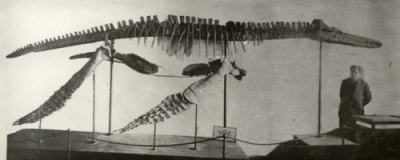
|
|
|
The first Pliosaur (Pliosaurus irgisensis) mounted in USSR in 1933. Curator of Local History Museum in Pugachovsk Mr. K. I. Zuravlev on the right. Back flipper is real, the front is gypsum, created by Zuravlev. The image is from Wikipedia |
The skeleton was on show of the museum between 1933 and October 1941. Unfortunately, due to bad storage condition during the World War II, most bones were destroyed or lost.
As it is the only fossil of Pliosaurus irgisensis known to date, due the fact that the species definition in 1948 was based on muzzle tip only, some paleontologists argue that this is not a valid species and instead is a variant of Pliosaurus rossicus or another Pliosaur.
The Woolly Mammoth (Mammuthus primigenius), is an extinct species of the mammoths of the elephant family who lived between 300 thousand and 200 thousand years ago, a tiny population of mammoths persisted on Wrangel Island, an Arctic island located off the coast of northern Russia, as late as 4,300 years ago.
"Mammoth, (genus Mammuthus), any member of an extinct group of elephants found as fossils in Pleistocene deposits
(2.6 million years ago - 11,700 years ago), over every continent except Australia and South America and in early Holocene deposits of North America.
The woolly, Northern, or Siberian mammoth (Mammuthus primigenius) is by far the best-known of all mammoths.
" ENCYCLOPADIA BRITANNICA
Siberian mammoth ivory is reported to have been exported to Russia and Europe in the 10th century. The first Siberian ivory to reach western Europe was brought to London in 1611. When Russia conquested Siberia, in the 16th and 17th centuries, the ivory trade grew and it became a widely exported commodity, with huge amounts being excavated.
According to some indigenous Siberian people, the mammoth was a creature that lived underground, burrowing tunnels as it moved, and would die if it accidentally tunneled to the surface where it was exposed to light or fresh air. Indigenous people thought the mammoth tusks are horns.

The reconstruction of the Mammuthus on the stamp is from a painting done by Soviet and Russian artist Vladimir Dmitrievich Kolganov. The skull on the stamp represents a skull of the second full skeleton found in Siberia in 1842, called Trofimov's after the Russian businessman who provided financial support for an expedition that looked for Mammoth bones for Russian Scientist Community. 
The image is from website of Paleontologic Museum in Moscow |

Painting of famous Soviet and Russian artist Vladimir Dmitrievich Kolganov (1923-2011), who designed many stamps of USSR
and made many drawings of prehistoric animals, based on their fossils, for the Paleontologic Museum in Moscow. |
Mammoth species can be identified by the number of enamel ridges on their molars; the primitive species had fewer ridges, and the amount increased gradually as new species evolved and replaced the older species. At the same time, the crowns of the teeth became longer, and the skulls become higher from top to bottom and shorter from the back to the front over time to accommodate this adaptation.
The oldest representative of Mammuthus, the South African mammoth (Mammuthus subplanifrons), appeared around 5 million years ago during the early Pliocene in what is now southern and eastern Africa. The last species to emerge, the woolly mammoth (Mammuthus primigenius), appeared about 300,000 years ago in East Asia, with some surviving on Russia's Wrangel Island in the Arctic Ocean until as recently as roughly 4,300 years ago, still extant during the construction of the Great Pyramid of ancient Egypt.
The Woolly Mammoths were perfectly adapted to life in the harsh conditions of the cold climate of North Europe and North America. One of their characteristic features was a dense coat. According to the excavated remains, they lived in family groups of 10-30 individuals, just like modern elephants. Compared to modern elephants, mammoths had a more massive body, shorter legs, longer hair, smaller ears and long curved tusks; the latter could serve the mammoth to obtain food in the winter from under the snow. [R4]
There are many Mammoth fossils and even entire mummified carcasses found in the Siberian region of Russia.
The earliest paleontological research on the bones and tusks of mammoths was done by Statesman and historian Vasily Nikitich Tatishchev (1686-1750).
In 1720, Tatishchev was sent to the Ural Mountains (the Ural Mountains or simply the Urals are a mountain range that runs approximately from north to south through western Russia, from the coast of the Arctic Ocean to the river Ural and northwestern Kazakhstan. The mountain range forms part of the conventional boundary between the continents of Europe and Asia.) to search for iron and other metals, identify places for the construction of metallurgical factories and run all metallurgical processing in the Ural region, to allow to Russian army to restore their arsenal as most of cannons and other weapons were destroyed during Russian-Sweden war (1700-1721).
As he arrived, he started to collect folklore stories about a mysterious animal - mammoth.
He also spent significant effort to collect some remains of the animal, "to see and investigate it".
 V. N. Tatishchev, USSR 1991, MiNr. 6253, Scott. 6052
V. N. Tatishchev, USSR 1991, MiNr. 6253, Scott. 6052
|
In 1724 he went to Sweden to study mining sciences. In Stockholm he was introduced to professor E. Benzel, who studied people and animals of the North regions of Europe.
Next year, in 1725, Tatishchev published an article about his investigations of mammoth bones: «Mamontova Kost' hoc est Ossa Subterranea, Fossilia, Ingentia, Ignoti Animalis, E Siberia Adferri Coepta, Duabus Perillustrium Atque Generosissimorum Virorum Literis, Brevique Commentario Dilucidata», in order to satisfy the interest of Swedish scientists in mammoths. This article is the very first scientific article in the world dedicated to the investigation of the Mammoths.
In this article, he described the mammoth fossils as bones of organic rather than mineral origin, as most of the contemporary scientific community believed, he also cited many of the local stories about the mammoths that he collected during his stay in Siberia.”.
He believed that the mammoth is not an elephant, but a special animal, whose horns are mined under the name of “mammoth bone”. In his article, Tatishchev rejected, at that time, a popular explanation for the origin of the “ivory” bones in Siberia, which implied the transfer of these bones by the waters of the Noah flood from India.
In his later articles, Tatishchev agreed that mammoth bones are similar to bones of Indian elephants and continued to reject an idea that they were moved from India by the biblical flood. He continue to insist that the mammoth bones found in the places were mammoths lived and suggested, that in the past Siberia was located closer to the Equator and had much warmer weather.
Tatishchev encouraged locals to search for complete skeletons of mammoths. Unfortunately, it was a half-century after his death before a complete skeleton was found
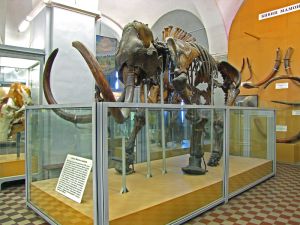 Adam's Mammoth on exhibit at the Zoological Museum of the Academy of Sciences in St. Petersburg
Adam's Mammoth on exhibit at the Zoological Museum of the Academy of Sciences in St. Petersburg
|
In 1806, zoologist and botanist Mikhail Ivanovich Adams (1780–1832), who was in Yakutsk at that time, was told about this discovery and organized the excavation and delivery of the skeleton to St. Petersburg (capital of Russia at this time), where it was mounted and exhibited for the public in 1808.
This skeleton known as Adam's Mammoth today and is still on the exhibit of the Zoological Museum of the Academy of Sciences in St. Petersburg. This discovery made it absolutely clear that the mammoth is not an Indian elephant as he was covered by a wool and displayed some other anatomical differences.
The first skeleton of Mammoth mounted in West Europe is the Lier Mammoth, founded on 28th February, 1860 by François-Joseph Scohy near the Dungelhoeffkazerne in Lier in the Province of Antwerp of Belgium, while digging the diversion canal of the Nete river. Shown for the public in the first time in 1869, it was the only second mounted Mammoth skeleton in the world and the fisrt Mammoth fossils found outside of permafrost region of Siberia.
Because the skeleton is incomplete, some bones were recreated in wood. Originally, all recreated bones were white, as you can see in the video below, but nowadays it painted by the same color as original bones and cannot be easily recongized.
Today, the skeleton is preserved in the museum of the Royal Belgian Institute of Natural Sciences in Brussels.
According to the length of the right tusk that was found (the left one is reconstructed) the skeleton belongs to a male animal, who died in age of 30-35 years old.
In 1799, the same year when the first full skeleton of Mammoth discovered Siberia, German naturalist Johann Friedrich Blumenbach gave the woolly mammoth its scientific name, Elephas primigenius, placing it in the same genus as the Asian elephant. In «Handbuch der Naturgeschichte. 6. Aufl. Göttingen» book he named some odd bones of an elephant that lived in Europe in antique times as bones of Elephas primigenius, which means the "first elephant" in Latin.
In his book, Blumenbach mentioned some elephant bones which were unearthed at the end of 1695 in sand pit near the settelment of Burgtonna
, near Gotha town in Germany.
These fossils were controversial at the time they were discovered, as there was a lot of debate on the origin of these bones.
This scientific debate was the very first debate on the origin of Mammoth bones.
The scientific community (Collegium Medicum) in Gotha considered them to be of mineral origin, as this was the
common opinion about the origin of fossils at this time.
However, German historian Wilhelm Ernst Tenzel, in his work "Epistola de sceleto elephantino",
published in Latin in 1696, claimed that these bones belong to an elephant
that most likely died during the Flood.
In 1699, some more bones of the "elephant", include the skull, teeth and tusks were found at a site nearby the original find,
which was used by Tenzel as confirmation of his theory.
After the Second World War, Blumenbach's original specimens were declared to be lost or destroyed, but was rediscovered
at the University Goettingen in 2008.
 Baron Georges Leopold Cuvier, France 1968, MiNr. 1672 , Scott. 1829
Baron Georges Leopold Cuvier, France 1968, MiNr. 1672 , Scott. 1829
|
In 1828 Joshua Brooks used modern scientific name of the "Mammoth" Mammuthus primigenius in a list of his zoological collection "A catalogue of the anatomical and zoological museum of Joshua Brooks".
During the Eighteenth and Nineteenth centuries, just over 20 finds of mammoth remains including frozen carcasses and skeletons with some soft tissues and skin still attached had been found in Siberia.” It can also be assumed that other carcasses are still partially or wholly frozen in the permafrost in Siberia. Even today it is still difficult to travel to the far corners of Siberia. Extracting the body from the frozen ground and transporting it back to the lab for study is very difficult. With the increasing development of Siberia during the twentieth and twenty-first centuries, the region has become more accessible and the number of finds has doubled.
Some very well-preserved remains have led some scientists to think that Mammoths could be brought back to life through genetic manipulation and cloning. If this is the case, then perhaps some day Mammoths could be released into the wild in Siberia.
Giant Deer (Megaloceros giganteus), is an extinct large artiodactyl mammal from the genus of Megaloceras.
"Megaloceros giganteus, also called Giant Deer, extinct species of deer, characterized by immense body size and wide antlers, commonly found as fossils in Pleistocene deposits in Europe and Asia (the Pleistocene Epoch began 2.6 million years ago and ended about 11,700 years ago) " ENCYCLOPADIA BRITANNICA
This deer, contemporary of the Mammoth and the wooly Rhinoceros, was indeed a giant, as males were up to 700 kg in weight and stood about 2.1 meters tall at the withers.They carried proportionally huge antlers with a maximum tip to tip length of 3.65 meters. The antlers were up to 50 kg in weight, which are the largest antlers of any known deer.
Similar to modern deer, the female animals were smaller and antlerless, while males replaced their antlers every mating season. According to the recent research Megaloceros giganteus is most closely related to present-day fallow deer (Dama dama). A small population of Megaloceros giganteus survived in the Siberian region of Russia until 7,000 years ago (probably even to more recent time).
Around 17,000 years ago humans saw these glorious creatures and created their own interpretations of them on the cave walls at Lascaux, and others at Cougnac. These exquisite paintings depict Megaloceros giganteus with speckled coats and dark shoulder hair that accentuated a distinctive hump. Due the fact that the hump does not show in fossils, the cave art really helps with reconstruction of the animal.
The animal often called the Irish Elk, however it is not an elk, but a deer, nor it unique to Ireland.
Although the Giant Deer ranged from mainland Europe through Siberia to northern Africa, almost all of the surviving skeletons and skulls are Irish. This is due to the unique composition of Irish bogs. It seems the unfortunate top-heavy beasts regularly came to sticky ends mired in muddy lakes. The bog grew over them, fossilizing their remains, until they were uncovered by turf-cutters.

|
| The oldest drawing of skull and antlers of a “Giant Deer” from 1588 |
The drawing was accompanied by a letter in 1597 that was sent with the antlers to England where it is assumed that Cecil put them up on the wall of his home at Theobalds House, Hertfordshire. Unfortunately it not survived until today.
The oldest fossil of Megaloceros giganteus that survived till today is a braincase and part of antlers that was found in Bad Cannstatt village near Stuttgart in Germany, in 1600. As it was a different from any known ruminant, it kept in a curiosity cabinet. Nowadays it is on display in Natural History Museum in Stuttgart.
It was only in 1697 when the Irish aristocratic scholar Thomas Molyneux identified large antlers from Dardistown, Dublin — which were apparently commonly unearthed in Ireland, as belonging to the “Great Irish Elk”.
Molyneux, as well as all other scientists at this time who believed in the Divine creation of the Earth and its life, had a difficulties to find an explanation about extinction of the animal. It was common belief at this time, that a God who created the world and all that was in it would not allow his creations to disappear from existence.
Not finding the Irish elk in Ireland, he concluded that it was once abundant on the island, suggested that an epidemic distemper as a cause of the animal's extinction and believed that the antlers belonged to an Irish version of the American moose, of which he had only a hazy idea. The English word for moose was elk and so the "Great Irish Elk" was born. The misnomer would last for centuries.
Only in 1812 French scientist Georges Cuvier, who first developed the theory of extinction caused by catastrophes responsible for wiping out the Earth’s species “to prove the existence of a world previous to ours, destroyed by some kind of catastrophe”, documented that the Irish elk along with other fossil vertebrates such as the mammoth, did not belong to any living species of mammal, declaring the Irish elk as the most famous of all fossil ruminants: "in some parts of the country they have been found so often, that far from being regarded as objects of any extraordinary interest, they have been either thrown aside as lumber, or applied to the commonest economical uses."
On August 14th 1819 the first, nearly, complete specimen of the species found by a blacksmith Thomas Kewish in marl pit (by "marl” is usually meant an open-water mud rich in calcium carbonate deposited principally by the plant Chara. Such a mud gives clear evidence of the former existence of a lake in whose calcium-rich deposits bone would be readily preserved) at Loughan Ruy, a basin on the Ballaugh gravel fan, Isle of Man.
Only few bones were are missing in the skeleton, most notably the pelvis. Kewish used a large horse pelvis, among a few other things, to fill in the gaps.
John Stevens Henslow, British botanist and geologist, best remembered as friend and mentor to his pupil Charles Darwin, who was doing some research on the island at the time of the discovery mentioned in one of his letters that a local blacksmith took a horse skeleton as model for his reconstruction of the Elk and made it with a great accuracy.

|

|
| The drawing of Irish elk from Isle of Man from a book “Essay on the THEORY OF THE EARTH, BY Baron G. Cuvier” published in 1827 | The skeleton of Irish elk from Isle of Man on display in the National Museums Scotland |
The first scientific name of the “Elk” given by German naturalist Johann Friedrich Blumenbach when he mentioned Alce gigantea in his book - «Handbuch der Naturgeschichte. 6. Aufl. Göttingen» in 1799. Alce gigantea means "Giant Elk" in Latin.
The modern scientific name “Megaloceros” appeared for the first time in "A catalogue of the anatomical and zoological museum of Joshua Brooks", published by British naturalist Joshua Brooks on 1827 (spelled as Megalocerus in the earlier editions, but corrected in 1828).
The first skeleton of Megaloceros giganteus from Russia was discovered in 1886.
The peasant Karl Krysinsky, who lived in Kamyshlov, asked, through his friend, the secretary of the Ural Society of Natural Science Lovers (USNSL) in Yekaterinburg, Onisim Yegorovich Kler, for help selling the skeleton of a big deer.
USNSL established on December 29th 1870, was one of the biggest Society of Natural Science Lovers in Russia. The Society had its own museum and library. Members of the Society made many discoveries and published many scientific articles on various Natural Science topics. Some artifacts from their museum were studied by major zoologists, paleontologists and geologists of Russia. It was closed by the communist regime in 1929 who considered it as potential stronghold of the "counterrevolutionary bourgeois intelligentsia", many of its members were repressed.

|
| Onisim Yegorovich Kler (1845-1920), the Image is from: https://m.vk.com/@museum_nature-o-megalocerose |

|
| Christian Yakovleivich Tal, the image is from http://www.1723.ru/read/dai2/dai-2-65.htm |
By examining the skull and some bones provided by Krysinsky, Kler and another member of the society, Christian Yakovleivich Tal recognized that they belonged to an individual of Cervus megaceros. (Cervus megaceros is one of the earliest synonyms for Megaloceros giganteus)
As it was the first such skeleton discovered in Russia, and one of very few skeletons of Megaloceros giganteus mounted in Natural History Museums around the world to date, the Society decided to purchase it for their own museum. After some negotiation and compromising on the price, the Society paid 300 Rubles, instead of 500 Rubles as asked on the beginning, a quite large sum at the time, to Krysinsky.
The same year, 1886, one of the buildings of the mining department located in the center of Yekaterinburg, was donated to the Society by one of their members, the director of the Ural factories I.P. Ivanov with kind permission of the minister of the state property in St. Petersburg (the capital of Russia at this time).
After some additional digging, an almost complete skeleton was transferred to the Society and was quickly assembled by the preparator Alfred Ignatievich Gakkel for the Siberian-Ural Scientific and Industrial Exhibition, organized by the Society, in 1887.
The mounted skeleton of Megaloceros was one of the main attractions at the Expo.

|
| The skeleton of Megaloceros giganteus in exhibit of Natural History Museum in Yekaterinburg. The image is from the article “О широкорогом олене” by Marya Morozova |
At the end of the Expo, the skeleton of Megaloceros giganteus was returned to the Museum of the Society which opened its doors to the public after some reconstruction.
In August 1897 the skeleton of Megaloceros giganteus was joined on display by an incomplete skeleton of Mammoth, which was also discovered not far from Kamyshlov.
Nowadays, both skeletons are exhibited in the Sverdlovsk Regional Museum of Local Lore in Yekaterinburg.
In the 1990's, the skeleton of the Giant Deer was completely renovated, the missing legs were reconstructed by molding the mirror images of the legs present. The broken and missing bones were reconstructed.
According to radiocarbon analysis, the skeleton belonged to the latest of all known Megaloceros - this deer lived 6.8 thousand years ago, whereas the remains of the Irish Megaloceros went extinct 10-11 thousand years ago.
The second, and at the moment, most complete skeleton of Megaloceros giganteus found in Russia, was discovered as much as 40 years later.
On July 8, 1926, a peasant, Vasilij Kanin from the village of Kanina went to the market in Sapozhek in the Ryazan region. He stopped to drink water from a rill by the Sapozhek River, two kilometers from the town. As he laid on his paunch to take a drink, he rested his hand on a twig – only to discover that the twig was actually a bone. When he arrived in town, he informed the director of the local history museum, doctor Pavel Petrovich Stakhanov. The Doctor was known for his obsession of finding a skeleton of the Giant Deer. This obsession started when he was able to acquire a skull with partially preserved antlers of a Giant Deer from an unknown peasant in the market in 1898.
Stakhanov examined the site where the bone was found, and recognized antlers that belonged to Megaloceros giganteus. He hired three workers at his own expense, who began an excavation under very hard conditions, standing in the icy water of the rill on unstable bed. Excavated bones were very fragile and crumbled away in the hands. They were taken out of the mud with great care, as if they were the most precious of jewels. For several months, Stakhanov dried the bones, until all the moisture was gone and the bones had hardened.
The skeleton consisted of two hind legs, spine, pelvis, skull, and neck. A local craftsman carved the lost fragments of the right horn from wood. Stakhanov was afraid to drill the fragile bones, therefore, he mounted the entire skeleton on a metal framework and tied the antlers to the ceiling. In the summer of the following year, Stakhanov went to look for the missing bones, by searching in the stream and the bed of the rill. Lucky enough he found the right humerus, two phalanges, the bones of the front leg, and a vertebra.
When done, he informed the Paleontologic Museum in Moscow about the find and exchanged some letters with spouse-paleontologists Pavlov (Maria Vasilievna and Alexey Petrovich), who studied and described fossils of Megaloceros giganteus from Galkino too. The spouses visited Sapozhek in 1927 where they studied the fossil and visited the site where the fossils were found.
They were very excited, as the skeleton was preserved in very good condition and it was only the second one found in Russia to date. Later on, this skeleton was transferred to the Paleontological Museum of the Russian Academy of Sciences in Moscow, where it is still on exhibit today.
[R5]
Products
| Official Products | ||
| FDC | Mini-Sheet | Booklet with Mini-Sheet with stamps of type 2 |
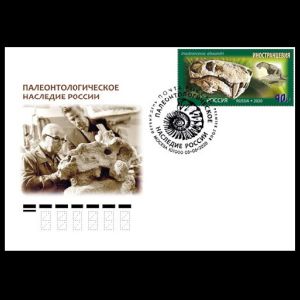
|

|

|
| Personalized Products | ||
| Maxi Cards | Commemorative Postcards | Examples of circulated covers and postcards |

|

|
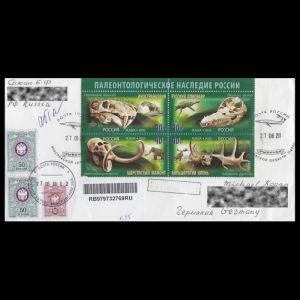
|
[PM1] Sevastopol is the largest city on the Crimean Peninsula and a major Black Sea port.
Since annexing Crimea in 2014, the Russian Federation has administered Sevastopol as a federal city.
Nevertheless, Ukraine and most of the UN member countries continue to regard Sevastopol as a city with special status within Ukraine.
References:
[R1] Rusmarka: official stamps release on English, on Russian (verbose)
Press release on official site of Paleotologic Museum in Moscow (on Russian only)
[R2] References and additional information about Inostrancevia and its discovery
Inostrancevia
|
[R2a] Vladimir Prokhorovich Amalitskii (discover of Inostrancevia)
|
[R3] References and additional information about Pliosaur and its discovery
Pliosaur
|
[R3a] Konstantin Ivanovich Zhuravlev (discover of the fisrt fossils of Pliosaur in Russia)
|
[R4] References and additional information about Mammoth and its discovery
- Britanica
- Wikipedia (Mammoth)
- Wikipedia (Woolly mammoth)
- Wikipedia (about Mammoth on Russian)
- Wikipedia (about Woolly Mammoth on Russian)
- ZIN Museum (on Russian)
- Woolly Mammoth: The Autopsy
(47 minute video) - Trofimov's Mammoth (on Russian)
- "Case 2726. Mammuthus Brookes 1828 Mammalia Proboscidea Proposed Conservation And Elephas primigenius Blumenbach 1799 Currently Mammuthus primigenius Proposed Designation As The Type Species Of Mammuthus And Designation Of A Neotype"
- Systematics 2008 Göttingen, Programme and Abstract
- Adam's Mammoth discovery by Tilesius von Tilenau (Electronic book on old Russian)
- Wikiwand (on Russian)
- extinct-animals.fandom.com
- Planetguide.ru (on Russian)
part I part II - cyberleninka.ru (on Russian)
- yakutskhistory.net (on Russian)
- Interview withKolganov's daughter
- Blumenbach, Johann Friedrich: Handbuch der Naturgeschichte. 6. Aufl. Göttingen, 1799
- Lier_mammoth
|
|
|
|
[R6] Sevastopol: Wikipedia
[R7] Paleontologic Museum in Moscow: official site
Acknowledge:
Many thanks to fellow collector Dr. Peter Voice, Western Michigan University and the Michigan Geological Survey, USA, for his notes and draft page review.
Many thanks to the following persons for nice conversations, their clarifications and help to find some information:
Constantin Tarasenko, Chief Curator of Paleontologic Museum in Moscow
Anton E. Nelikhov, author of book "The inventor of the pareiasaurs. Paleontologist V.P. Amalitsky and his gallery"
Daniil Naumov, expert in biography of Russian paleontologist and artist Alexey Petrovich Bystrov
Fellow collector Andrey Enyashin, for his help to find some information about Russian paleontologists.


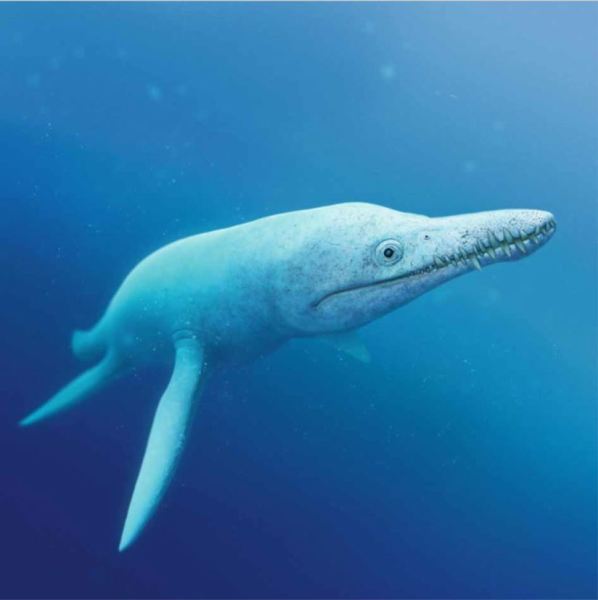 Painting of famous Russian paleo-artist Andrey Atuchin "Pliosaurus rossicus", who created it in 2018
as an illustration for a book about prehistoric animals of the Volga River region "Kogda Volga byla morem. Leviafany i
piligrimy", 2nd edition, (ISBN 978-5-91304-432-7)
Painting of famous Russian paleo-artist Andrey Atuchin "Pliosaurus rossicus", who created it in 2018
as an illustration for a book about prehistoric animals of the Volga River region "Kogda Volga byla morem. Leviafany i
piligrimy", 2nd edition, (ISBN 978-5-91304-432-7)



